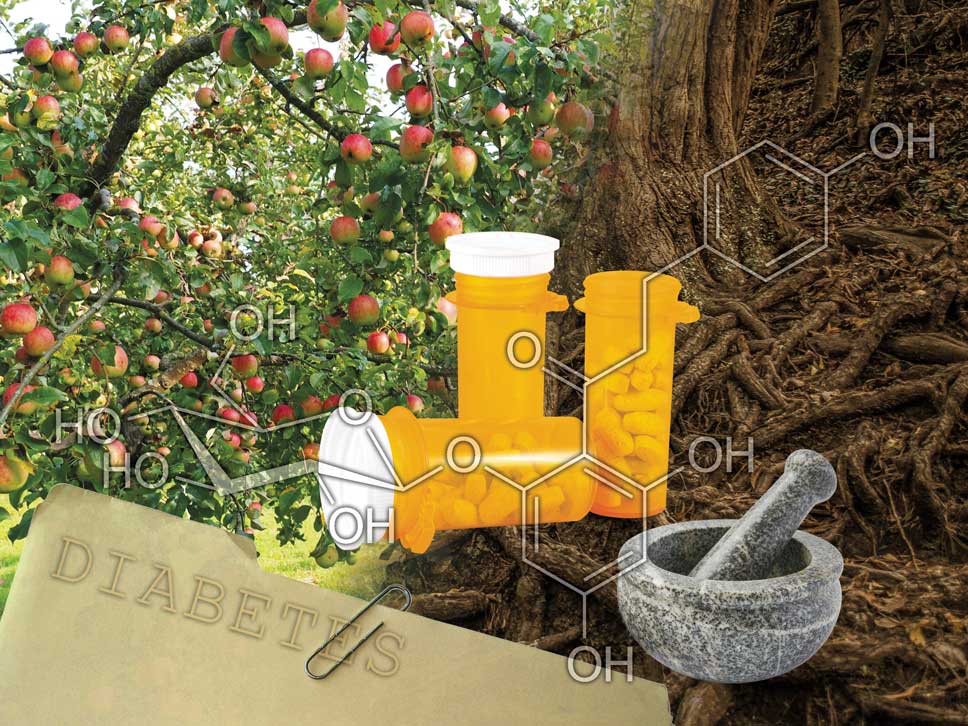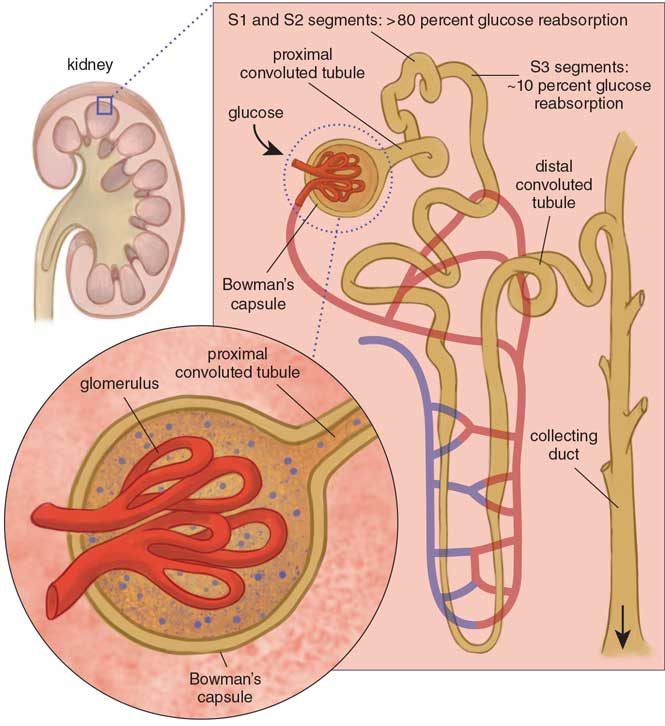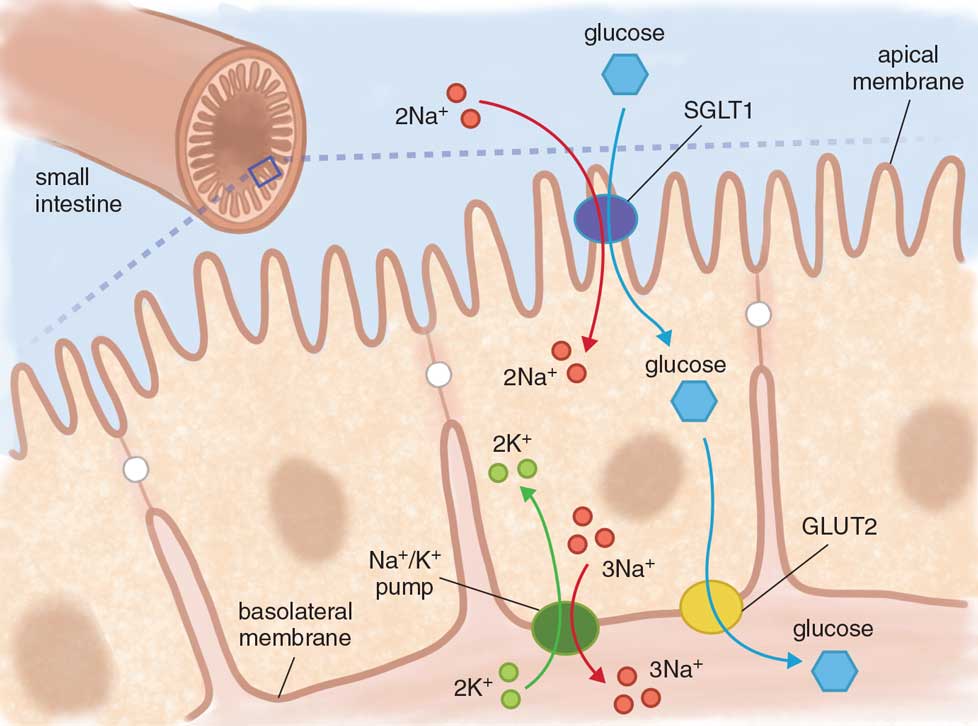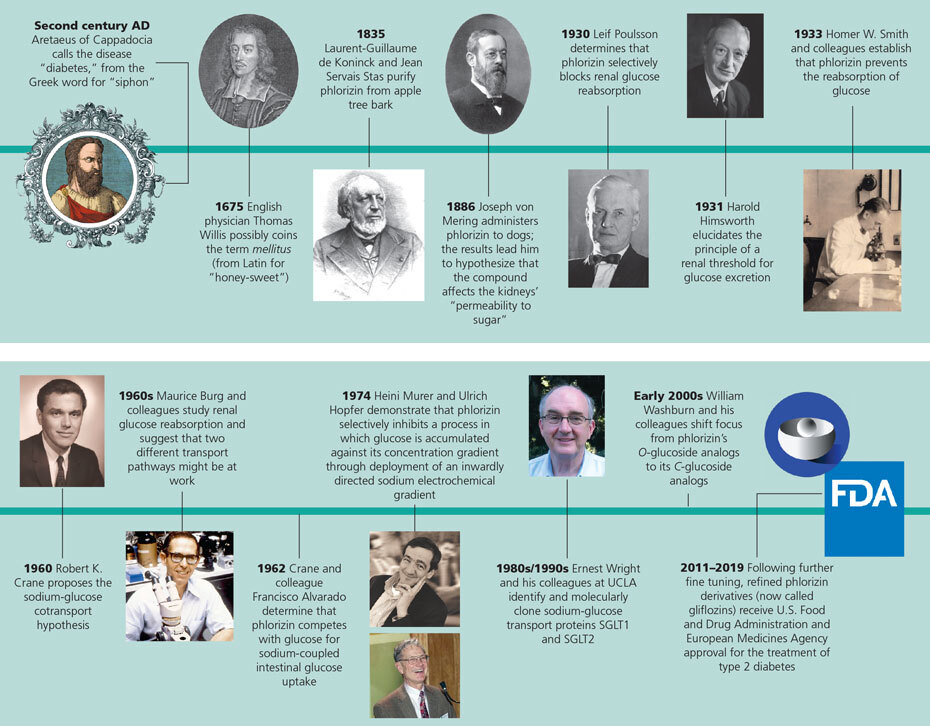Gliflozins for Diabetes: From Bark to Bench to Bedside
By Philip A. Rea
Drugs targeting the kidneys for diabetes treatment stem from almost two centuries of research that began with an uprooted apple orchard.
Drugs targeting the kidneys for diabetes treatment stem from almost two centuries of research that began with an uprooted apple orchard.

Almost two millennia ago, a Greek physician from a rugged plateau in the middle of present-day Turkey was confronted with patients in Alexandria who urinated excessively and complained of insatiable thirst. An eclectic scholar known for reviving the teachings of Hippocrates, Aretaeus of Cappadocia called the disease “diabetes,” from the Greek word for “siphon.” English physician Thomas Willis (1621–1675) is often credited as the first to add the descriptor mellitus (Latin for “honey-sweet”), which refers to the smell and taste of sugar in the urine, a characteristic that many ancient physicians had also observed.
Today, people with diabetes mellitus have access to a wide array of drugs that increase the sugar-regulating hormone insulin and reduce glucose production and absorption, yet the battle against diabetes is far from over. The International Diabetes Federation reports that diabetes affects about 1 in 10 adults aged 20 to 79 years, many of whom go untreated. Half of people with diabetes are unaware they even have the condition. Moreover, even though two of the defining symptoms of the disease—polyuria (excessive urine production) and glucosuria (glucose in the urine)—have long been linked to kidney function, it was not until the early 2010s that the U.S. Food and Drug Administration (FDA) and the European Medicines Agency (EMA) approved the first drugs that treat the disease by targeting the kidney.
Since their approval, these new drugs, called gliflozins, have offered targeted inhibition of glucose reabsorption by the kidneys while lowering risks of hypoglycemia and weight gain compared with some other diabetes drugs, such as the sulfonylureas. They also offer a variety of remarkable additional benefits: Research suggests gliflozins can help protect people—with or without diabetes—from cardiovascular disease and end-stage renal disease. Evidence also suggests that gliflozins delay the progression of chronic kidney disease in both groups.

Barbara Aulicino; photos: rawpixel.com, Wikimedia Commons
Gliflozins are unquestionably blockbusters. In 2023, empagliflozin (Jardiance) alone posted sales of $8 billion, while the world’s best-selling medication, Merck & Company’s cancer drug Keytruda, made $25 billion.
According to the U.S. Centers for Disease Control and Prevention (CDC), more than 37 million Americans have diabetes mellitus; 90–95 percent of them have type 2 diabetes, in which the body cannot appropriately regulate blood sugar levels and metabolism, either because cells resist the effects of insulin, or because the pancreas makes too little of it. A significant factor behind type 2’s prevalence is the rise in obesity: Between 1999 and 2020, obesity increased in prevalence from 30.5 to 41.9 percent of the U.S. population, and severe obesity rose from 4.7 to 9.2 percent, according to the CDC. Fat buildup around the abdomen and organs is associated with insulin resistance, in which an abnormal response to insulin impairs glucose’s entry into cells, causing it to build up in the blood. Although type 2 diabetes most often develops in people 45 or older, children, teens, and young adults are increasingly being diagnosed with the disease due to a surge in childhood obesity.
People with type 2 diabetes experience a variety of negative health impacts, including problems with their eyes (such as diabetic retinopathy, cataracts, and glaucoma), gums, feet, and nerves. They also face increased risks of developing a variety of other health conditions. According to the American Diabetes Association, cardiovascular disease occurs twice as often in people with diabetes and accounts for two-thirds of deaths in people with type 2 diabetes. Moreover, nearly one-third of people diagnosed with diabetes have kidney disease, according to statistics from the National Institute of Diabetes and Digestive and Kidney Diseases. The CDC reports that diabetes is the most common cause of renal failure, a condition in which kidneys can no longer properly filter toxins from the blood, and of end-stage renal disease, in which a patient has permanently lost most kidney function and requires dialysis or a transplant for survival.
Alarming as these statistics are, they are just the tip of an international iceberg: A Global Burden of Disease study published in The Lancet in 2023 found that half a billion people worldwide had type 2 diabetes mellitus in 2021. The number was projected to more than double to about 1.3 billion by 2050, leading to a parallel rise in cardiovascular and renal complications. The need for drugs like gliflozins is therefore imminent and acute.
But the road to the development of these vital drugs took many twists and turns and combined numerous fields of research. It is therefore useful to trace one line of evidence to its end before doubling back to review others.
Gliflozins are a family of drugs that trace their origins to the natural product phlorizin, whose name is rooted in the ancient Greek words phlóos (“bark”) and rhíza (“root”). Discovered in Brussels in 1835 by Laurent-Guillaume de Koninck (1809–1887) and Jean Servais Stas (1813–1891), phlorizin provided the structure upon which gliflozins would be modeled a century later.
The discovery of phlorizin occurred partly through serendipity: As it happened, the hiring of de Koninck and Stas as research assistants to Jean-Baptiste Van Mons (1765–1842) at the State University of Louvain coincided with the senior scientist having his apple orchard dug up for relocation. Had the two young men not taken that opportunity to explore the medicinal potential of the root bark of their boss’s apple trees (Malus domestica), it’s unclear whether or when scientists might have isolated the first crystals of phlorizin.
Bark extracts had been used in Europe to treat and abate fevers associated with malaria since the early 1600s, when Jesuit missionaries brought them to Spain from the Americas, and quinine was first isolated from the bark of cinchona trees (Cinchona spp.) in 1820. So it is not surprising that de Koninck explored phlorizin’s applications in fighting fever and pathogens. Though unsuccessful, this research later caught the eye of the German physician Joseph von Mering (1849–1908) at the University of Strasbourg.
It was von Mering who, together with Oskar Minkowski (1858–1931), performed a famous 1889 experiment in which they removed a dog’s pancreas, which resulted in profuse urination and death. Aware of the connection between polyuria and diabetes, the pair analyzed the urine to find that it was high in sugar, thereby elucidating the root cause of type 1 diabetes mellitus, an autoimmune condition in which the body’s immune system attacks the insulin-producing beta cells in the pancreas, leading to a lack of insulin production.

Stephanie Freese
Research soon showed that phlorizin had a marked effect on glucose absorption, which then led to several key discoveries regarding the mechanisms behind diabetes mellitus. Von Mering is chiefly relevant to the story of phlorizin (and its eventual offshoots, the gliflozins) for having been the first scientist to demonstrate phlorizin diabetes, a term he used to differentiate the diabetes-like symptoms elicited by phlorizin administration from symptoms associated with “classical” diabetes. In the latter, increased urinary glucose was associated with higher blood glucose levels; conversely, in phlorizin diabetes, urinary glucose increase was accompanied by a decrease in blood glucose levels. Today, we might construe this as the “gliflozin effect.”
In 1886—three years before the work he did with Minkowski on pancreatectomized dogs established the link between diabetes and the pancreas—von Mering reported that administering phlorizin to dogs orally or subcutaneously triggered the profuse production of sugary urine, but without an increase in blood glucose. He attributed this effect to the possibility that the compound “may induce glucosuria by changing something in the kidney,” for instance, “its permeability to sugar.” Notably, von Mering distinguished phlorizin diabetes from the disease as it typically presented by proposing that phlorizin’s action had something to do with kidney function. Minkowski closed the loop in 1892 by showing that removing the kidneys from otherwise healthy pancreatectomized dogs abolished phlorizin’s capacity to lower blood glucose levels.
Although von Mering came close to broadly defining phlorizin’s action, it was not until the 1930s that an understanding of the salient features of kidney function and phlorizin diabetes would lead to an explanation of the causes and consequences of renal glucose reabsorption. Three sets of investigations, spearheaded by Norwegian, British, and American investigators, respectively, were decisive here. First, building on von Mering’s experiments, Leif Poulsson (1930) determined that phlorizin selectively blocks kidney-dependent (renal) glucose reabsorption, causing glucosuria while leaving other urinary constituents such as creatinine unaffected. Next, Harold Himsworth (1931) demonstrated a threshold for renal glucose excretion: When blood glucose concentrations fall below this threshold, glucose reabsorption by the kidneys is so effective that none is found in the urine; when the threshold is exceeded, a proportional amount of glucose starts to appear in the urine. Finally, Homer W. Smith and colleagues (1933) established that intravenously administered phlorizin prevented the near-complete reabsorption of glucose that was otherwise seen in healthy people. The overarching principle that emerged from these investigations is that phlorizin increases urinary glucose by decreasing the renal threshold—the plasma glucose concentration at which significant urinary glucose excretion occurs—by inhibiting glucose reabsorption by the kidneys.
But what biochemical mechanisms could explain phlorizin’s effects on the kidneys? The insights that answered that question did not at first come from kidney research at all, but rather from investigations of dietary glucose absorption in the small intestine. At issue was a basic question: How do cells in the intestinal lining absorb glucose, and where do they get the energy to do so, especially when its transport must be “uphill” against its concentration gradient?

Stephanie Freese
On August 24, 1960, at the Symposium on Membrane Transport and Metabolism in Prague, Robert K. Crane from Washington University Medical School in St. Louis proposed a novel explanation: the sodium-glucose cotransport hypothesis. In his speculations, hurriedly sketched on a paper napkin immediately before his talk at the symposium, Crane proposed that the uphill transport of dietary glucose across the epithelial cell membranes of the small intestine is driven by the movement of sodium ions, which naturally flow from regions of high concentration outside the cells to regions of lower concentration inside. In essence, the glucose “hitched a ride” with the sodium ions. Although others—such as Edward Waymouth Reid of the University of St. Andrews (as early as 1902), and Emanuel Ricklis and Juda Hirsch Quastel of McGill University–Montreal General Hospital Research Institute (only a few years before the Prague meeting)—had previously considered the effects of mineral salts on intestinal sugar transport, Crane was the first to suggest that the flux of an ion might be coupled to the transport of another solute (glucose) in such a way as to drive the latter’s uphill transport.
The insights that resulted in a precise definition of the kidney transporters came from investigations of glucose absorption in the small intestine.
Phlorizin now reenters the story as a linchpin in validating Crane’s hypothesis. In 1962, Crane and his colleague Francisco Alvarado at Washington University School of Medicine in St. Louis had demonstrated that phlorizin can obstruct the cotransport process by vying with glucose for seats on the proverbial sodium-ion bus. In the early 1970s, Heini Murer and Ulrich Hopfer from the Swiss Federal Institute of Technology at ETH Zurich took this result a step further in their seminal in vitro experiments on vesicles—closed spheres less than 1 micrometer in diameter that are derived from the intestinal lining. The magic of membrane vesicles is that they preserve many properties of the membrane they were sampled from, including the membrane proteins essential for glucose transport and absorption.
The crux of Murer and Hopfer’s findings was that, when the glucose concentration inside the intestinal vesicles was lower than the concentration on the outside, glucose moved passively inward, down its concentration gradient, without the need for accompanying ions. However, when the glucose concentration was reversed, such that it was greater on the inside than on the outside, glucose entry required the presence of sodium ions on the outside of the vesicles to create an inwardly directed sodium electrochemical gradient across the vesicle membranes. That is, the energy released when the sodium ions moved downhill (down their electrochemical gradient) could be harnessed to drive the movement of the glucose uphill (against its concentration gradient).
As we’ve seen, research had shown how phlorizin from the root bark of apple trees could increase urinary glucose while lowering blood glucose. Later research revealed that this occurred because phlorizin selectively blocks the reabsorption of glucose into the bloodstream by the kidneys. Now, Murer and Hopfer had laid the foundations for understanding what phlorizin was blocking: the sodium cotransport process. Later work on the small intestine in the 1980s would define the membrane proteins responsible for this process.
Think of intestinal dietary glucose uptake as a combination of two processes. The first occurs “downhill.” It requires no energy, because it involves the passive movement of glucose down its gradient—that is, from regions of high concentration to regions of low concentration. But this movement of glucose doesn’t just happen on its own; it requires the help of a special transporter protein called GLUT2 (GLUcose Transporter 2). The second process is the one discussed earlier, which involves moving against the gradient by latching onto the “downhill” movement of sodium ions. This involves a cotransport protein called SGLT1 (sodium-glucose cotransporter 1).
A key distinction between these glucose transporters—and their relevance for treating type 2 diabetes—is that GLUT transporters are sensitive to phloretin, a part of the larger phlorizin molecule, but not to phlorizin itself. Conversely, SGLT transporters are inhibited by phlorizin but not by phloretin. Gradually, it became clear that these same factors, with a few key differences, were at work in the kidneys, too.
The mechanism of glucose reabsorption by kidney cells parallels the mechanism at work in the small intestine with a few significant differences. As in intestinal uptake, kidney uptake initially involves the uphill movement of glucose into the epithelial cells via SGLT-mediated transport, after which a GLUT-mediated transport process moves glucose out of these cells into the bloodstream. However, whereas the intestinal system relies on a single type of sodium-glucose cotransporter (SGLT1), the renal system requires the participation of two (SGLT2 as well as SGLT1).

Stephanie Freese
Long before the proteins were identified in the 1980s, however, hints that renal glucose reabsorption utilized a second transporter had cropped up in other studies and experiments. That possibility was raised in human genetics, for example, by two heritable conditions that seemed to disengage the intestinal glucose uptake from kidney glucose uptake: Familial renal glucosuria, first described in 1927, involves increased urinary glucose excretion despite normal blood glucose levels and unimpaired intestinal glucose uptake, whereas the congenital disorder glucose galactose malabsorption, first described in 1962, entails severely impaired intestinal uptake of glucose and galactose (a sugar less soluble and less sweet than glucose), but only mild glucosuria. The implication, since confirmed, is that there are two SGLTs: one that (when mutated) results in impaired renal glucose reabsorption with little or no effect on intestinal uptake, and another that (when mutated) results in markedly impaired intestinal glucose and galactose uptake but only mild impairment of renal glucose transport.
Meanwhile, transport experiments on animals, too, suggested a second SGLT. In rabbits, the kidney structures corresponding to human S1/S2 and S3 segments reflected the pattern discussed earlier: a low-affinity, high-capacity transporter (at work in S1/S2) and a high-affinity, low-capacity transporter (at work in S3). The functions of SGLT2 (in S1 and S2) and SGLT1 (in S3) were identified by groundbreaking work in the 1980s and early 1990s by Ernest Wright and his colleagues at UCLA, who cloned SGLT1 from rabbits and subsequently found human versions of both SGLT1 (in the intestine and kidney) and SGLT2 (mainly in the kidney). To grasp what’s going on here, it’s helpful to review the roles played by S1/S2 and S3.
Kidneys filter blood by passing it through tiny tufts of capillaries called glomeruli. The thin walls of each glomerulus allow smaller molecules (such as waste products, mineral ions, and glucose) to pass into a filtrate. This fluid then flows through a coiled structure called the convoluted tubule while the glomeruli retain the blood cells and proteins in the bloodstream. In the 1960s, studying segments of this tubule that were proximal to (just downstream of) a glomerulus, Maurice Burg and his colleagues at the National Institutes of Health made two key findings. They discovered that the capacity for glucose reabsorption from the glomerular filtrate was approximately 10-fold greater in the early segments of the tubule (labeled S1 and S2) than in the later segment (labeled S3). They also noted that glucose uptake by the S1 and S2 segments was by means of a phlorizin-sensitive process with a low affinity for glucose, whereas S3 segment uptake occurred through a phlorizin-sensitive process with a high affinity for glucose.
In other words, the two sections of the proximal convoluted tubule functioned quite differently in how they reabsorbed glucose from the bloodstream. S1 and S2 absorbed more glucose, but only when there was a high concentration of it, whereas S3 could absorb glucose when its concentration was low but could not absorb very much of it. It was as if two different phlorizin-sensitive glucose transporters (or different versions of the same one) were involved. These results sparked a great deal of excitement among researchers seeking treatments for type 2 diabetes. The possibility of a high-efficacy, high-specificity renal glucose reabsorption inhibitor suggested a way to push back on the high blood glucose levels, or hyperglycemia, that accompany insulin resistance. In vivo studies demonstrated phlorizin’s capacity to reverse hyperglycemia and insulin resistance, and to restore tissue insulin sensitivity in diabetic rats without affecting insulin action in rats that had normal pancreatic function.
Compelling as these results were, several factors worked against phlorizin as an ideal drug for treating type 2 diabetes. First, it has only limited water solubility and poor bioavailability when taken orally, meaning only a small amount of it would reach the bloodstream if it were swallowed as a pill. To make matters worse, phlorizin’s structure makes it vulnerable to being broken down in the intestine by digestive enzymes known as beta-glucosidases. Second, while phlorizin primarily inhibits SGLT2, the glucose cotransporter specific to the kidney, it also inhibits SGLT1, which is found in both the kidney and small intestine. So using phlorizin could risk amping up gastrointestinal problems—mimicking the severe diarrhea and dehydration of glucose galactose malabsorption, described above—unless such a drug could maximize its selectivity toward SGLT2 over SGLT1.

Philip Rea
Although several alternate O-glucoside derivatives of phlorizin partially overcame some of these limitations, phlorizin still faced many problems as a drug for treating type 2 diabetes. It was not until investigators, starting with William Washburn and his colleagues at Bristol Myers Squibb at the turn of the 21st century, shifted their focus to phlorizin’s C-glucoside analogs that the field really took off.
Here at last was the culmination of more than a century of work, and a transformative moment in the treatment of diabetes: Realizing that the breakdown of phlorizin in the intestinal tract was due to its O-glucoside structure (in which the glucose molecule is attached to phloretin via an oxygen atom), the researchers began investigating the possibilities of modified versions of phlorizin with C-glucoside structures (in which the glucose molecule is attached via a carbon atom instead). With an eye to maximizing the inhibitory potency of these drugs toward SGLT2 over SGLT1, researchers made further structural refinements to the phlorizin molecule, culminating in the development of four gliflozins that received FDA and EMA approval between 2011 and 2019: dapagliflozin by Bristol Myers Squibb, canagliflozin by Mitsubishi Tanabe Pharma Corp. (marketed under license by Johnson & Johnson), empagliflozin by Boehringer Ingelheim and Eli Lily and Co., and ertugliflozin by Pfizer and Merck. All preferentially inhibit SGLT2 over SGLT1, and all effectively increase urinary glucose content by decreasing the renal threshold for glucose excretion. Current studies show gliflozins reduce glycated hemoglobin (HbA1c, a key long-term blood sugar marker) by approximately 0.7 percent. At least one of the drugs, canagliflozin, improves glycemic control both when used by itself and when combined with metformin and/or insulin. (See “Metformin: Out of Backwaters and into the Mainstream,” March–April 2017.)
Joseph von Mering proposed that phlorizin’s action had something to do with kidney function.
And then there are the additional benefits. People with diabetes are twice as likely to develop cardiovascular disease, and diabetes is a major driver of end-stage renal disease. Encouraging, therefore, is recent evidence indicating that gliflozins confer significant protection from both comorbidities in patients, whether they have diabetes or not. A clinical trial described in a 2015 issue of the New England Journal of Medicine linked unexpected cardiac benefits with empagliflozin, including a 14 percent decrease in cardiovascular death, nonfatal myocardial infarction, or stroke; a 32 percent relative reduction in risk of all-cause mortality; and a 35 percent decrease in relative risk of hospitalization for heart failure. As described in a 2022 scientific statement about SGLT2 inhibitors from the American Heart Association published in Circulation, cardiovascular risk reduction was subsequently shown to occur with other drugs in this class (canagliflozin, dapagliflozin, and ertugliflozin), in both patients who have diabetes and those who do not.
The results of clinical trials published in the New England Journal of Medicine (2020) and Annual Review of Medicine (2023) showed that gliflozins also delay the progression of chronic kidney disease in patients with or without type 2 diabetes. Secondary analyses of the cardiovascular trials and subsequent dedicated kidney trials have consistently confirmed improved kidney-related outcomes regardless of type 2 diabetes status. As extrapolated in a 2021 study in Kidney360, a gliflozin such as canagliflozin could potentially delay the onset of end-stage renal disease by more than 15 years.
The unanticipated cardiorenal effects of these agents have expanded their uses beyond patients with type 2 diabetes. In fact, sotagliflozin, the first combined SGLT1 and SGLT2 inhibitor to be approved by the FDA (in 2023), entered the market not as a treatment for type 1 diabetes (for which it was rejected) but instead as a way to lower the risk of cardiovascular death, hospitalization for heart failure, and urgent hospital admissions in adults with heart failure or type 2 diabetes, chronic kidney disease, and other cardiovascular risk factors.
Few if any drugs provide health benefits without potential side effects. In gliflozins, these most commonly include urinary tract infections (UTIs), genital yeast infections, and increased urination, although evidence linking gliflozins to UTIs is inconsistent. According to a 2017 meta-analysis of randomized controlled trials published in Diabetes, Obesity and Metabolism, it is widely accepted that gliflozins increase the risk of mild, easily treated female genital infections such as the yeast infection candidiasis by 3 to 5 times. However, according to that same review, although early studies suggested a connection between gliflozins and UTIs, recent meta-analyses have not supported this relationship, except with respect to dapagliflozin.
A rare but potentially serious side effect of gliflozin therapy is diabetic ketoacidosis, with the greatest risk (according to a multicenter cohort study published in 2020 in Annals of Internal Medicine) linked to canagliflozin, followed by empagliflozin and dapagliflozin. The mechanism underlying this complication remains to be determined, but one hypothesis suggests that, by decreasing blood glucose levels through increased glucosuria, gliflozins induce a pseudofasting state and a greater reliance on fats for energy. This, in turn, decreases the insulin requirements while also increasing glucagon levels and ketone body production.
Though gliflozins alone seldom cause hypoglycemia, the condition sometimes occurs when gliflozins are coadministered with insulin or agents (such as sulfonylureas) that promote insulin secretion, as described in a nationwide cohort study published in 2020 in BMJ Open Diabetes Research & Care. In brief, the most common side effect of this drug class is genital mycotic infections.
Ultimately, it is the combination of side benefits and lowered risks that makes gliflozins truly stand out. Sulfonylureas typically offer greater HbA1c reduction, but with higher risks of hypoglycemia and weight gain. Metformin offers reductions similar to those offered by sulfonylureas, but without the cardiovascular and renal protective effects that gliflozins offer. Unfortunately, until they come off patent, gliflozins are more expensive than metformin, costing $250 to $650 for a 30-tablet, 10-milligram supply, compared with $4 to $11 for a 30-tablet, 500-milligram supply of the older drug.
We can forgive Aretaeus of Cappadocia, with his interest in the four humors theory and limited knowledge of kidney function beyond urine production, for not emphasizing the importance of renal processes in the disease he named. More difficult to fathom, perhaps, is how long it took for treatments specifically targeting the kidney to emerge among modern medications for diabetes management. In part, the delay can be attributed to an early and persistent focus on the pancreas and insulin, and of course many advances were only possible following significant advances in technology. Whatever the reasons, of the eleven or so drug classes currently available—insulin, sulfonylureas, metformin, alpha-glucosidase inhibitors, thiazolidinediones, meglitinides, amylin agonists, GLP-1 agonists, DPP4 inhibitors, colesevelam, and bromocriptine—only one, the gliflozins (the last to gain FDA and EMA approval for diabetes treatment), directly targets the kidney.
Diabetes mellitus affects about 1 in 10 adults 20 to 79 years old, half of whom are unaware they have it.
Given gliflozins’ proven effectiveness in treating type 2 diabetes mellitus, heart failure, and kidney disease, the discovery, development, and elucidation of the mechanism of action at work in this drug class should perhaps be lauded among the most important pharmaceutical advances of the 21st century, on par with the antihypertensives and statins of the 20th century. And it all began because a professor of chemistry hired two young research assistants shortly before he dug up his apple orchard almost 200 years ago.

Alamy; Wikimedia Commons; National Portrait Gallery; @ONaCVG/CERD-Collections CERD/ Wikimedia Commons; Mark Knepper/National Heart, Lung, and Blood Institute/CC BY-NC-ND; Heini Murer; LinkedIn; UCLA Medical School
The gliflozin story is a fascinating example of how mechanistic insights in one area can lead to advances in another. In 1960, Crane set the stage for identifying the target of gliflozin action by first seeding the idea of sodium-coupled glucose transport, albeit in the gut rather than the kidney. This was soon followed by phlorizin experiments conducted by him and Alvarado, which connected the processes occurring in the gut with what might be occurring in the kidney. What was known of familial renal glucosuria, a genetic condition first described in the 1920s, suggested that kidney glucose reabsorption might be significantly inhibited without affecting intestinal glucose transport. This prompted the rediscovery of phlorizin’s blood glucose lowering effects and inspired confidence in the feasibility of deploying drugs preferentially targeting SGLT2 for the treatment of type 2 diabetes. Equally exciting are the discoveries made both before and after, as exemplified by the elucidation of the molecular identities of the transporters responsible for renal glucose reabsorption, particularly the significance of the differences between SGLT2 and SGLT1.
And the story is far from over. With the completely unexpected post-marketing revelation that gliflozins push back not only on the type 2 diabetes epidemic but on two other conditions of similarly epidemic prevalence—cardiovascular disease and chronic renal disease—in people with or without diabetes, researchers are now more invested than ever in understanding gliflozins’ underlying mechanisms. With luck, the next phase of gliflozin research will be as fruitful in these expanded areas as the original research and development of phlorizin was in furnishing fresh insights into diabetes.
Click "American Scientist" to access home page
American Scientist Comments and Discussion
To discuss our articles or comment on them, please share them and tag American Scientist on social media platforms. Here are links to our profiles on Twitter, Facebook, and LinkedIn.
If we re-share your post, we will moderate comments/discussion following our comments policy.